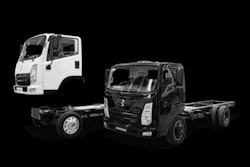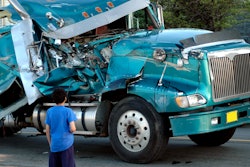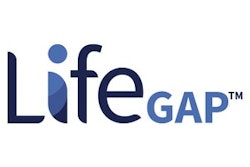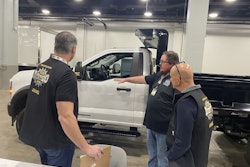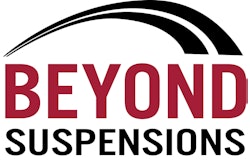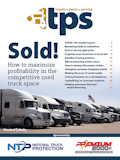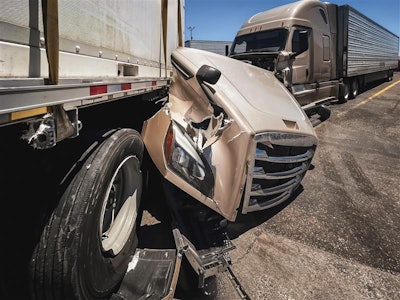
Insurance premium levels for the commercial vehicle sector are at all-time highs, numbers from the Bureau of Labor Statistics (BLS) show. Along with higher financing and vehicle costs, the higher premiums are part of a maelstrom of headwinds facing new truck and trailer sales.
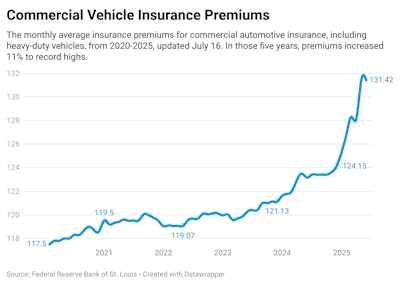
Avery Vise, vice president of trucking at FTR, says there are several factors behind the spike in premiums, including inflation.
[RELATED: Rising insurance premiums punish dealers’ bottom lines]
“If you think about even liability insurance, hospitalization costs have gone up, the cost of vehicles have gone up right,” Vise says. “If you’re in an accident and you damage a car or total a car, the cost of that goes up. The lost income goes up. You have the nuclear verdict issue, which is kind of its own issue, but you also have the fact the actual cost to replace things to compensate has gone up.”
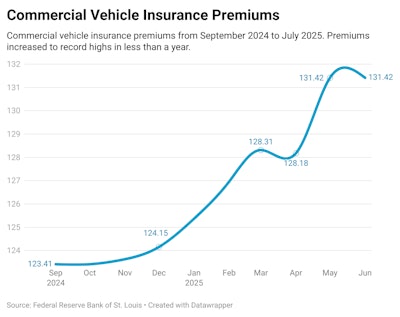
Whether investing in new trailers, power units or aftermarket accessories, the higher costs are leaving fleets and owner-operators alike watching their budgets and pausing purchases.
Marina Ivanov is the CEO and co-founder of Apex Transit Solutions in North Carolina. Her insurance is “always on the rise,” she says, with the exception of cargo and property damage which, for her, has come down. She says they’ve seen a decrease in exchange for taking a higher deductible.
“The general rising costs are causing us not to invest as much in safety technology,” she says. “We want to install cameras on the sides, but that is going to be a costly investment.”
Insurance operations
Commercial vehicle insurance, generally speaking, has three main parts: Cargo coverage, auto liability and physical damage. Thom Albrecht, CFO and chief revenue officer for Reliance Partners, a commercial transportation and trucking insurance firm, says most carriers carry around $1 million in auto liability per vehicle, which is above the federally mandated minimum of $750,000. Many large carriers are self-insured.
Auto liability is a traditional loss leader, Albrecht says. Like trucking companies, insurance companies have an operational ratio, sometimes called a loss ratio. They understand they’re going to lose money on certain parts of the portfolio, such as auto liability. Companies make it up in other parts of the portfolio, such as physical damage.
Physical damage policies cover damage to the policyholder’s truck and equipment in the event of an accident. As inflationary pressures exert themselves on new equipment and replacement parts alike, insurers are getting more aggressive with premium increases, Albrecht says.
Tariffs and insurance premiums
Trucks, trailers and parts have all gotten more expensive in recent years, thanks to advanced and more costly technology as well general macroeconomic inflation. Albrecht says many underwriters also are anticipating the inflationary result of any future tariffs on trucks and truck parts, particularly from Mexico and Canada, and that explains at least some of the increase since January.
“They are expecting the spare parts to go up a lot because of the embedded tariffs,” he says, even if those tariffs aren’t active yet, and even if not every replacement part is exposed. Uncertainty about both tariffs and tariff threats leaves underwriters preparing for the worst but hoping for the best.
Tyler Olson, vice president of operations at Housby, a Midwestern Mack and Isuzu dealer, says they aren’t seeing any abnormal adjustments to parts pricing yet.
“I am shocked underwriters are citing that since we have not seen or heard it on the parts side,” he says. “For the OEMs we represent — Mack, Autocar, Cummins, Isuzu and VCE — we have not seen currently any out of the norm.”
What may be happening is that underwriters are looking at a longer-term forecast than suppliers, distributors and dealers are when it comes to pricing parts.
Olson says Isuzu, as one example, were the last of his manufacturers to put a surcharge on vehicles because they themselves hadn’t yet seen an increase amidst the turmoil over tariffs.
“It’s extremely confusing and frustrating, frankly,” Albercht says. But that’s what underwriters are bracing for.”
Litigation's effects
Litigation also influences insurance premiums, and not just nuclear verdicts. Run-of-the-mill litigation is also spiking costs for insurers in the commercial market, with cases settling for hundreds of thousands more than they used to.
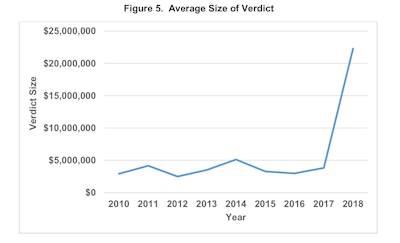 Source: ATRI, Understanding the Impact of Nuclear Verdicts on the Trucking Industry, June 2020
Source: ATRI, Understanding the Impact of Nuclear Verdicts on the Trucking Industry, June 2020
“Maybe five to seven years ago, a broken leg and lost wages might have represented $80,000 to $100,000,” Albrecht says. “We see the same claim settle [today] for $300,000 to $400,000.”
Plaintiff’s attorneys have mastered the art of playing to a jury’s emotions, he says, while trucking companies’ defense strategies are just now catching up.
Both Ivanov and Michael Castaldi, who owns MDC Transport out of Deltona, Fla., blame rising settlement costs and nuclear verdicts, or at least the fear of them, for higher rates. Castaldi says he hasn’t seen a major increase in his own premiums, but adds he’s had the same agent for more than 30 years and the same insurance company for 20.
Rising premiums and sales
With freight rates rolling around the bottom of the market and costs — including insurance premiums — soaring, carriers are cutting where they can. That includes opting for less expensive used trucks and trailers versus new, when they have to buy at all, Albrecht says. Used trucks also cost less to insure than newer rigs.
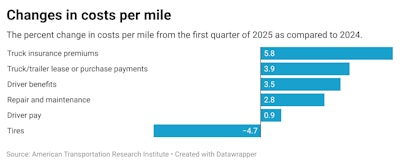
“Not to state the obvious,” Ken Vieth, president and senior analyst at ACT Research says, “when carriers make money, they buy equipment. When they don’t make money, they rein in their equipment purchases. … I suspect when the market is ascending and rates are rising, insurance premiums are not even a topic of discussion. When the market is bouncing along the bottom, insurance is just one in a long list of reasons not to buy.”
Olson says among his customers, rocky conditions are showing up in budget-friendly aftermarket parts orders and an interest in refurbished power units.
“A lot of our customers are not purchasing new units right now unless they had trucks on order with us,” Olson says. “To date, we have not had any canceled orders, however, most of the units on order for 2025 were placed while we were still on allocations in 2024.”
Housby recently started refurbishing used trucks. It completed 25 units for two customers, and he says conversations with customers are leading to more refurbishments in the future.
“We have not seen much movement in the new truck segments, with some customers in larger companies admitting they are waiting to see what pans out,” he says.
Castaldi calls insurance “a necessary evil,” and says high costs and low freight rates are keeping him out of new equipment.
“Today’s new equipment is way overpriced, in my opinion, and the freight rates don’t warrant the price,” he says. “I’m happy to ride it out with what I have.”
ATRI data shows as new Class 8 sales lag, the used market is showing some life. ACT Research says June used Class 8 retail prices jumped 6.2% month over month in June and 10.4% year over year in the same month.
“Used Class 8 sleepers … have increased in average price each month from November 2024 to March 2025 — the first sustained rise since early 2022 — suggesting at least some truck demand has transferred to the used market under these adverse conditions,” ATRI adds in its recent report, Analysis of the Operational Costs of Trucking: 2025 Update.
ATRI data shows just how adverse those conditions are. On average, insurance premiums make up $0.102 per mile, the report says. Compare that to driver wages ($0.798 per mile), tires ($0.047), and repair and maintenance ($0.198). The report shows 5.8% increase per mile from the first quarter of this year as compared to 2024.

